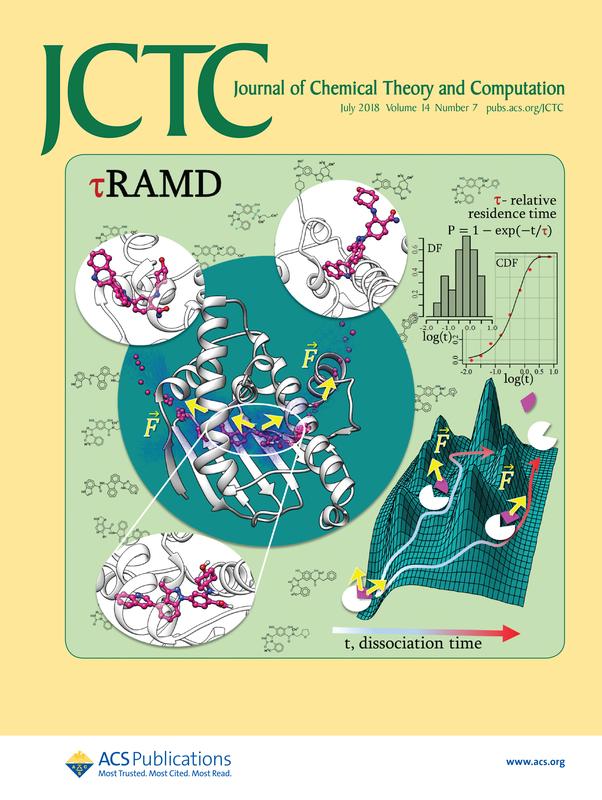New computational method for drug discovery

Cover image: The TauRAMD method is based on the Random Acceleration Molecular Dynamics technique and designed for computation of the relative residence times, tau, of drug-like compounds. Daria Kokh, HITS (courtesy of: JCTC)
The design of a drug with a desired duration of action, whether long or short, is usually a complicated and expensive trial-and-error process guided only by a mix of expert intuition and serendipity. One of the parameters affecting drug efficacy is the lifetime of the complex formed between a drug and its target protein, whose function must be altered, e.g. inhibited. In practice, many possible chemical compounds have to be synthesized and then tested to discover an appropriate drug candidate.
Easy method and high performance
As a part of the Kinetics for Drug Discovery (K4DD) project supported by the EU/EFPIA Innovative Medicines Initiative Joint Undertaking, researchers at the Molecular and Cellular Modeling (MCM) group at the Heidelberg Institute for Theoretical Studies (HITS) developed a computationally efficient and easy-to-use method for predicting the relative lifetimes of complexes of a target protein with different drug candidates.
The scientists demonstrated the high predictive performance of the computational approach using experimental data measured by collaborators at Merck KGaA (Darmstadt), Sanofi-Aventis Deutschland (Frankfurt am Main), and Sanofi R&D (Vitry-sur-Seine, France).
The method, called tauRAMD (residence time, tau, estimation using Random Acceleration Molecular Dynamics simulations) has been developed for ease of use and makes it possible to compute long residence times with short simulations. It has been successfully applied to diverse sets of compounds binding a range of therapeutically important target proteins. It is described in an open-access publication (https://pubs.acs.org/doi/abs/10.1021/acs.jctc.8b00230), and the software is freely available ( https://www.h-its.org/downloads/ramd/).
Media Contact:
Dr. Peter Saueressig
Head of Communications
Heidelberg Institute for Theoretical Studies (HITS)
Phone: +49 6221 533 245
peter.saueressig@h-its.org
The Heidelberg Institute for Theoretical Studies (HITS) was established in 2010 by the physicist and SAP co-founder Klaus Tschira (1940-2015) and the Klaus Tschira Foundation as a private, non-profit research institute. HITS conducts basic research in the natural sciences, mathematics and computer science, with a focus on the processing, structuring, and analyzing of large amounts of complex data and the development of computational methods and software. The research fields range from molecular biology to astrophysics. The shareholders of HITS are the HITS Stiftung, which is a subsidiary of the Klaus Tschira Foundation, Heidelberg University and the Karlsruhe Institute of Technology (KIT). HITS also cooperates with other universities and research institutes and with industrial partners. The base funding of HITS is provided by the HITS Stiftung with funds received from the Klaus Tschira Foundation. The primary external funding agencies are the Federal Ministry of Education and Research (BMBF), the German Research Foundation (DFG), and the European Union.
Prof. Dr. Rebecca Wade
Molecular and Cellular Modeling Group
Heidelberg Institute for Theoretical Studies (HITS)
Phone: +49 6221 533 247
rebecca.wade@h-its.org
Estimation of Drug-Target Residence Times by τ-Random Acceleration Molecular Dynamics Simulations. Daria Kokh*, Marta Amaral, Joerg Bomke, Ulrich Grädler, Djordje Musil, Hans-Peter Buchstaller, Matthias K. Dreyer, Matthias Frech, Maryse Lowinski, Francois Vallee, Marc Bianciotto, Alexey Rak, and Rebecca C. Wade*. J. Chem. Theory Comput., 2018, 14 (7), pp 3859–3869. DOI: 10.1021/acs.jctc.8b00230
*corresponding authors
https://www.h-its.org/scientific-news/tauramd_en/ HITS press release
https://pubs.acs.org/doi/abs/10.1021/acs.jctc.8b00230 Original publication
https://www.h-its.org/downloads/ramd/ Software download
Media Contact
All latest news from the category: Life Sciences and Chemistry
Articles and reports from the Life Sciences and chemistry area deal with applied and basic research into modern biology, chemistry and human medicine.
Valuable information can be found on a range of life sciences fields including bacteriology, biochemistry, bionics, bioinformatics, biophysics, biotechnology, genetics, geobotany, human biology, marine biology, microbiology, molecular biology, cellular biology, zoology, bioinorganic chemistry, microchemistry and environmental chemistry.
Newest articles

A universal framework for spatial biology
SpatialData is a freely accessible tool to unify and integrate data from different omics technologies accounting for spatial information, which can provide holistic insights into health and disease. Biological processes…

How complex biological processes arise
A $20 million grant from the U.S. National Science Foundation (NSF) will support the establishment and operation of the National Synthesis Center for Emergence in the Molecular and Cellular Sciences (NCEMS) at…

Airborne single-photon lidar system achieves high-resolution 3D imaging
Compact, low-power system opens doors for photon-efficient drone and satellite-based environmental monitoring and mapping. Researchers have developed a compact and lightweight single-photon airborne lidar system that can acquire high-resolution 3D…





















